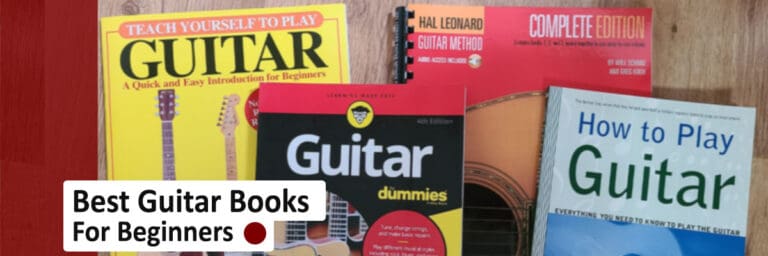I was contacted by the author of The Big Serious Guitar Book, Geoff Stockton, asking if I would like to receive a copy and write a review, and since I'm always on the lookout for new guitar material, I said sure.

This self published book sells for around $40 on Lulu. When I first saw the rather steep price, I got curious. Most guitar books sell for $5 to $20. What could this have that would warrant the price?
The first thing I noticed was that The Big Serious Guitar Book is just as it's name says. BIG 🙂 In fact, it's over 500 pages big. Looking through my library of guitar books, I could not find any other book nearly as long.
Secondly, having a quick peek at the contents, it has a wealth of information that you won't really find in one place anywhere else. In essence, this book could easily replace several other books based on the amount of content presented.
So my first impression was basically positive, now let's have a look inside.
The Table of Contents
I don't know about you, but the first thing I like to look at when I'm looking to buy a book is the table of contents. You can pretty much instantly tell whether it's right for you or not.
Here is the index of The Big Serious Guitar Book, bare with me:
| Chapter | Title | Page |
|---|---|---|
| 1 | Introduction | 3 |
| 2 | Getting Started | 5 |
| 3 | Basic Guitar Technique | 11 |
| 4 | Music Reading – An Introduction | 14 |
| 5 | Fretboard Mapping - Part 1: The Essentials | 20 |
| 6 | Rhythm – Part 1: Simple Words | 22 |
| 7 | The Major Scale | 25 |
| 8 | Rhythm – Part 2: Rests | 31 |
| 9 | The Cycle of 5ths | 33 |
| 10 | Fretboard Mapping - Part 2: Major Scale Positions | 34 |
| 11 | Music Reading - Part 2: The Fret Board in All Keys | 35 |
| 12 | Diatonic Harmony - Part 1: Triads | 36 |
| 13 | Chord Progressions - Part 1: Major I – IV – V Changes | 40 |
| 14 | The Chord-Tone Pattern | 42 |
| 15 | Diatonic Harmony - Part 2: Transposition and Bar Chords | 46 |
| 16 | Recognizing Tonality | 52 |
| 17 | The Natural Minor Scale | 55 |
| 18 | Diatonic Harmony – Part 3: Power Chords | 61 |
| 19 | The Pentatonic Scale | 65 |
| 20 | Rhythm – part 3: Other Simple Time Signatures | 74 |
| 21 | Essential Techniques | 76 |
| 22 | Chord Progressions – part 2: Diatonic Chord Substitution | 87 |
| 23 | Melodic Patterns – Part 1 | 91 |
| 24 | Basic Triad Inversion | 131 |
| 25 | Diatonic Harmony – Part 4: Four Note Chords | 134 |
| 26 | Triad Pairs | 148 |
| 27 | The Modes of the Major Scale | 161 |
| 28 | Arpeggios – Part 1: Chords of the Major Scale | 194 |
| 29 | Chord Progressions – Part 3: The 12-Bar Blues | 219 |
| 30 | Rhythm – Part 4: Syncopation | 236 |
| 31 | Chord Progressions – Part 4: Interval Patterns | 240 |
| 32 | Diatonic Harmony – Part 5: Chords of the Harmonic Minor Scale | 243 |
| 33 | Harmonic Minor Scale Positions | 245 |
| 34 | The Modes of the Harmonic Minor Scale | 246 |
| 35 | Harmonic Minor Chord Pairs | 258 |
| 36 | Symmetrical Harmony – Part 1: Simple Math | 264 |
| 37 | Rhythm – Part 5: Odd Subdivisions | 266 |
| 38 | Melodic Patterns – Part 2: Musical Applications | 272 |
| 39 | Non-Diatonic Harmony – Part 1: Secondary Dominant Chords | 277 |
| 40 | Chord Progressions – Part 5: Using Secondary Approaches | 279 |
| 41 | The Melodic Minor Scale | 281 |
| 42 | The Modes of the Melodic Minor Scale | 292 |
| 43 | The Melodic Craft – Part 1: Proper ties of Melody | 313 |
| 44 | Rhythm – Part 6: Compound Time Signatures | 323 |
| 45 | Diatonic Harmony – Part 6: Extended Chords | 334 |
| 46 | Arpeggios – Part 4: Triad Pairs of the Melodic Minor Scale | 342 |
| 47 | Chord Progressions – Part 6: Key Modulation | 353 |
| 48 | Navigating Modulations and Non-Diatonic Chords | 364 |
| 49 | Melodic Patterns – Part 3: Advanced Diatonic Motion | 366 |
| 50 | Non-Diatonic Harmony – Part 3: Tri-Tone Substitution | 386 |
| 51 | The Melodic Craft – Part 2: Chromaticism | 388 |
| 52 | Non-Diatonic Harmony – Part 3: More Chromatic Chords | 403 |
| 53 | Symmetrical Scales | 408 |
| 54 | Symmetrical Harmony – Part 2: Hidden Triad Families | 421 |
| 55 | Melodic Patterns – Part 4: Non-Harmonic Patterns | 428 |
| 56 | Jazz Licks – Over a IIm7-V7-Imaj7 Context | 440 |
| 57 | Diatonic Harmony – Part 7: Quartal Harmony | 451 |
| 58 | The Melodic Craft – Part 3: Motive Development | 455 |
| 59 | Harmonization | 463 |
| 60 | Background Writing – The Art of the Counter-Melody | 474 |
| 61 | About the Author | 477 |
| 62 | Music Notation to Fretboard Guide | 478 |
Wow, I don't blame you if all of the content is overwhelming at first sight. There are a lot of topics that most guitarists and musicians probably have never heard of, which is great, since this book may finally fill those gaps of knowledge that a lot of musicians have.
This brings us to an important topic.
Who is the book for?
When I first looked at the table of contents, I was a bit confused, since it starts out with very basic beginner stuff, and gradually moves into very advanced theory.
After going through the book, I can safely say that the book is not for beginners. Intermediate players? Well, maybe and maybe not. If they want to take it to the next level, advance and dive into the world of theory, than definitely.
Nevertheless, I feel it is the more advanced player that will get the most out of The Big Serious Guitar Book.
The beginner stuff is interesting to read, and Geoff has a descriptive, easy to digest style of writing, but beginners need more attention than what the initial chapters of the book can provide.
But that's OK, you can't have everything in one. There are loads of other books for beginners out there.
What the book is all about
Simply put, The Big Guitar Book explains guitar theory in a very practical manner and gives you lots of examples to practice theory in context.
Note that I said guitar theory, not simply music theory. Everything in the book is from the guitarist's perspective, for example, this bit on triad pairs:
If you’re playing rhythm guitar or comping over a vamp that shifts between two chords, a solid knowledge of these combinations will allow you to move anywhere on the fretboard with ease and grace. This allows you to duck and weave out of the way of a vocalist, soloist or keyboardist, which will lend a much more concise overall sound to the band.
Guitar-specific theoretical concepts are explained in a very descriptive and understandable manner, which is rather uncommon. Try looking elsewhere for specifically guitar theory content of this depth and quality... pretty hard to come by.
Most other guitar theory materials stop at scale modes and the CAGED system. Well, not this book.
The theory bit
Have a look at the table of contents again. Even if you call yourself an advanced player, I'm 100% sure you will find lots of theoretical stuff that this book will clear up for you. I'm also 99% sure you'll find brand new material you've never heard of before.
The amount of theory in this book could be almost overwhelming, but it's not. The Big Serious Guitar Book wasn't meant to be read and digested in a week, or a month, or even in a year.
Serious guitarists with songwriting aspirations will find it a gem, it'll really open up a world of possibilities. Unless you want to stay with your typical 4 chord songs that is 🙂
Starting out with the simpler theoretical concepts, like scale tones and the 12-bar blues, all the way to key modulations and jazz, everything is explained as clearly and understandably as possible.
The practice bit
As I mentioned, every theoretical concept explained is accompanied by practice exercises. At times, there are several pages of exercises on a given concept, which aim to get the reader familiar with it's sound across the entire fretboard. That is awesome!
It really shows that the author wanted to demonstrate every aspect of any given topic.
Oh yes, I want to emphasize that to get the most out of the book, you need to have your guitar in your hands and follow along musically.
Writing style
Everything is detailed and basically fun to read, even aspects that most teachers would not provide that much info on. It's cool how the author gives practical advice, examples, and tips on even heavier theory as well.
Why this is important? It's because he writes in a way that allows you to picture things in detail, which is very important since there is no video to accompany the material. But of course, you need to have your guitar handy.
Also, the language he uses is straightforward, like he was talking to a friend, which makes all the music theory stuff very readable and story-like.
Here is an example of using clear, understandable, and descriptive language in his explanation of the importance of intervals.
Understanding and recognizing these intervals is even more important than knowing the names of the notes because it’s the relationship between two notes that creates musical characteristics and qualities that effect us.
Well said.
Conclusion
Basically, the book has a wealth of information on pretty much every guitar-related topic, but I can imagine that the fact that it's just so BIG will put some people off. In today's fast-paced world, not many have the time or motivation to dive this deep into guitar theory.
Advanced guitarists or intermediate players who are interested in deeper theory should definitely get this book.
This is the 1st edition of The Big Serious Guitar Book, so I can imagine some things will be improved upon in the 2nd edition, like:
- Adding chapter and subchapter numberings.
- The practice exercises on each theory section is great, but I would also give real world examples in the form of famous songs/compositions that use the given bit of theory. Associating theory with a known song can really put things into context.
- Making the front cover and the layout of each page a little more eye-catching (the "Dummies" series does a really good job of this).
- Adding a final, conclusion chapter on where to now, how best to utilize the newfound knowledge, etc.
But these are just little nuances that would make an otherwise great guitar theory book even better.



First off, a big thank you to Tom for an awesome review and some very good advice for the second edition. I’m hoping to do a new edition every 4 years and release lots if other books in between editions of what will probably remain my flagship product, the Big Serious Guitar Book.
Secondly, I have recently posted some rather fat sample PDF chapters of the book on http://www.geoffstocktonmusic.com, in the instructional section. So if you want to be sure this book is worth the admittedly robust price tag, have a long look at the samples and I’m sure you’ll see what Tom’s talking about!